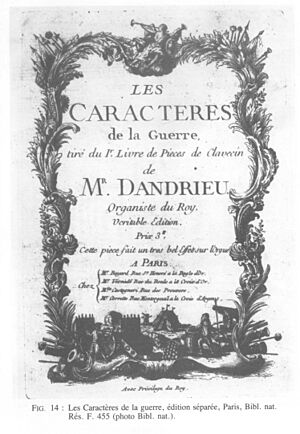Jean-François Dandrieu facts for kids
Jean-François Dandrieu (born around 1682, died 1738) was a famous French composer and musician. He lived during the Baroque period, a time when music was often grand and decorative. Dandrieu was especially good at playing the harpsichord and the organ. He is also known as D'Andrieu.
Contents
A Talented Young Musician
Jean-François Dandrieu was born in Paris, France. His family had many artists and musicians. He was a very gifted child. When he was just 5 years old, he gave his first public concerts. He played the harpsichord for King Louis XIV of France and his royal court. These early performances helped him start a very successful career as a harpsichordist and organist.
He learned music from a teacher named Jean-Baptiste Moreau.
Dandrieu's Important Music Jobs
In 1700, when Dandrieu was 18, he began playing the organ at the Saint-Merri church in Paris. He became the main organist there in 1705.
In 1721, he received a very important job. He was chosen as one of the four organists for the Chapelle royale of France. This was the King's own chapel.
In 1733, he took over from his uncle, Pierre Dandrieu, as the organist at the St Barthélémy church. This church is no longer standing today. Jean-François Dandrieu held both organ jobs at Saint-Merri and St Barthélémy.
He passed away in Paris in 1738. His sister, Jeanne-Françoise, then became the organist at St Barthélemy.
Dandrieu's Published Works
Jean-François Dandrieu published several collections of his music during his lifetime. These include:
- Livre de sonates en trio (1705): These were trio sonatas. A trio sonata is a piece of music for three instruments, usually two solo instruments and a bass instrument.
- Two Livres de sonates à violon seul (1710 and 1720): These were sonatas for a solo violin.
- Les caractères de la guerre (1718): This means "The Characters of War." These were instrumental concerts. A revised version was published in 1733.
- Three "little" harpsichord collections (1705) and three "great" ones (1724, 1728, and 1734).
After he died, his sister, Jeanne-Françoise, published a book of organ noëls (Christmas carols) in 1759. This book was an updated and larger version of a similar book by his uncle, Pierre Dandrieu.
Dandrieu also wrote an important book in 1718 called Principes de l'accompagnement. This book explained how to play musical accompaniment. Today, it helps us understand how music was played during his time.
Dandrieu's Music Style
Dandrieu's harpsichord music sounds a bit like the music of another famous French composer, François Couperin. However, Dandrieu used counterpoint more often. Counterpoint is when two or more independent melodies are played at the same time. This makes his music sometimes sound similar to German Baroque music.
Instead of strict traditional suites (a series of dance movements), Dandrieu often wrote pièces de caractère. These were pieces with descriptive titles, like "The Busy Bee" or "The Dreamer." This style was very popular in French music during the 18th century.
After the works of François Couperin and Jean-Nicolas Geoffroy, Dandrieu's harpsichord music is one of the largest collections from that time.
See also
- French baroque harpsichordists
- French organ school


